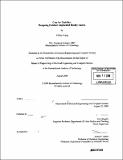| dc.contributor.advisor | Eric Klopfer. | en_US |
| dc.contributor.author | Wang, Tiffany (Tiffany N.) | en_US |
| dc.contributor.other | Massachusetts Institute of Technology. Dept. of Electrical Engineering and Computer Science. | en_US |
| dc.date.accessioned | 2009-08-26T16:43:01Z | |
| dc.date.available | 2009-08-26T16:43:01Z | |
| dc.date.copyright | 2008 | en_US |
| dc.date.issued | 2008 | en_US |
| dc.identifier.uri | http://hdl.handle.net/1721.1/46527 | |
| dc.description | Thesis (M. Eng.)--Massachusetts Institute of Technology, Dept. of Electrical Engineering and Computer Science, 2008. | en_US |
| dc.description | Pages 95-96 blank | en_US |
| dc.description | Includes bibliographical references (p. 87-88). | en_US |
| dc.description.abstract | Creating a successful Outdoor Augmented Reality (OAR) game can be a complicated process. With every new feature added to the OAR toolset, games gain more levels of complexity, grow in size of content, and become increasingly difficult to produce and manage. In order to identify plausible methods to help alleviate some of the difficulties when creating OAR games, a heuristic usability evaluation of the existing Game Editor toolkit and an assessment of the needs of game designers were made as part of this research. Two new applications, the Desktop Editor and Remote Editor, were designed, prototyped, and evaluated by new and experienced game designers. The Desktop Editor offers new methods of visualizing and working with data which have proven to be useful features for creating games but also add difficulties to overall learnability. The Remote Editor offers on-location game editing capabilities which help expedite many of the tasks involved with creating and testing OAR games. Feedback and user tests suggest that the new applications offer valuable ideas for game editing features that would be beneficial in future iterations of the OAR Game Editor toolkit. | en_US |
| dc.description.statementofresponsibility | by Tiffany Wang. | en_US |
| dc.format.extent | 96 p. | en_US |
| dc.language.iso | eng | en_US |
| dc.publisher | Massachusetts Institute of Technology | en_US |
| dc.rights | M.I.T. theses are protected by
copyright. They may be viewed from this source for any purpose, but
reproduction or distribution in any format is prohibited without written
permission. See provided URL for inquiries about permission. | en_US |
| dc.rights.uri | http://dspace.mit.edu/handle/1721.1/7582 | en_US |
| dc.subject | Electrical Engineering and Computer Science. | en_US |
| dc.title | Case for usability : designing Outdoor Augmented Reality games | en_US |
| dc.title.alternative | Designing Outdoor Augmented Reality games | en_US |
| dc.title.alternative | Designing OAR games | en_US |
| dc.type | Thesis | en_US |
| dc.description.degree | M.Eng. | en_US |
| dc.contributor.department | Massachusetts Institute of Technology. Department of Electrical Engineering and Computer Science | |
| dc.identifier.oclc | 414101135 | en_US |
